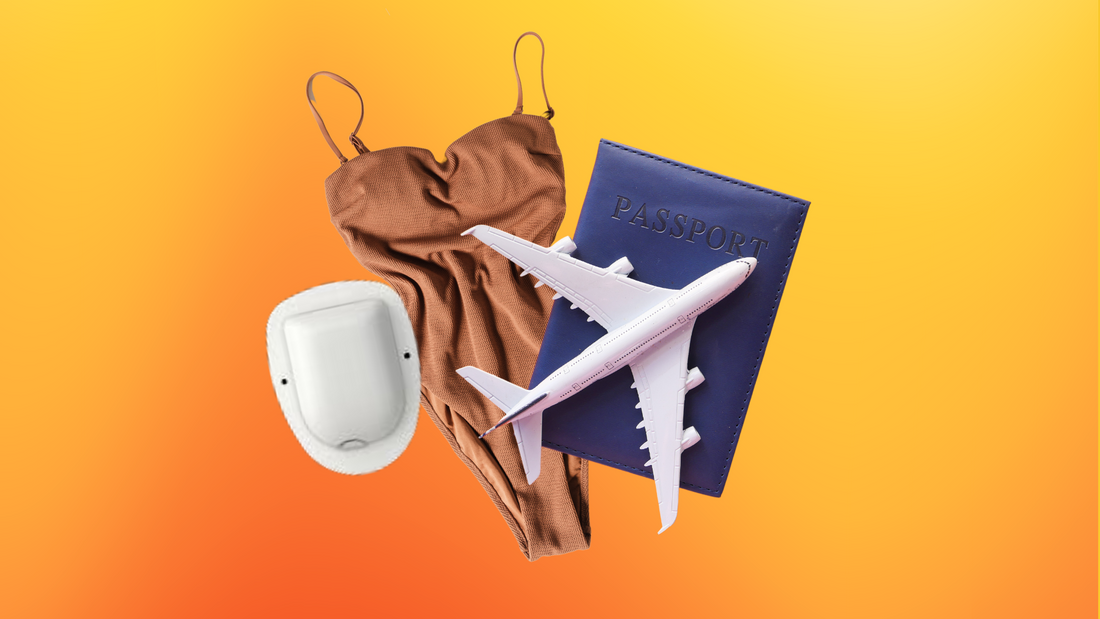This blog post was written in partnership with Omnipod Australia.
Picture this: It's a scorching summer day and you're lounging on a beach with the sun kissing your skin, the waves serenading your ears, and an ice-cold drink in hand. Sounds like a dream vacation, right?
Then your hypo alarm goes off …
Throwing diabetes in the mix can seem like an (extremely unwanted and uninvited) interruption to your ultimate holiday, but with some smart planning and a sunny disposition, you can have a fantastic summer vacation while keeping your diabetes in check.
1. Plan ahead 🗓️
Let’s start at the very beginning: planning!
Start by seeing your GP at least 3 months before you travel. This will leave time in case you need a series of vaccinations. You’ll also want to grab extra prescriptions for your current medications (including glucagon!) and plan for potential illnesses like gastro (yuck).
Next, book in with your Diabetes Educator (DE). You’ll want to ask them for a typed and signed letter proving your medical condition, an action plan for managing your insulin dosages during your flight or throughout different time zones and an emergency plan in case you experience any complications or illness in an unfamiliar place. You may also need to request access to additional NDSS supplies if you’re travelling for a longer period.
Hot tip! While you’re chatting with your Educator, ask for an update on new tech that might be available to you to improve travelling with diabetes. Whether it’s giving continuous glucose monitoring a go, or using a tubeless insulin pump, you’ll have a couple of months to trial something new to see if it makes your management simpler.
Travel insurance is something everyone should travel with, but it gets a little more complicated when you add medical conditions into the mix. It’s best to read the terms and conditions before booking travel insurance to make sure the accident and health cover applies to pre-existing conditions (like diabetes), the places you’re visiting and the activities you plan on doing (like skiing or bungy jumping - eek!).
Do a little detective work about your destination. Where is the nearest pharmacy or medical facility? What kind of food options are available? Armed with knowledge, you can hit the road (or the skies) with confidence.
2. Pack more than the essentials 💉
It’s time to do some diabetes maths and figure out exactly how much you need to pack. And no, we’re not talking about how many pairs of shoes … we’re talking insulin pump consumables, CGM sensors, needles, strips and insulin. This is a great conversation to have with your DE particularly if you haven’t travelled in a little while (or ever).
Pack all your diabetes supplies in your carry-on if you’re flying (including hypo snacks!), just in case your luggage gets lost in transit. This also ensures your supplies stay at optimal temperatures. Also consider sharing some of your supplies with a travel partner in case your bag gets stolen or lost.
Have all your syringes and insulin supplies clearly marked with the pharmacy-labelled packaging. Keep your emergency plan and contact list in your carry-on luggage or in your phone/wallet. Include contacts for your travel insurer or travel organisers in this list.
Hot tip! Running or walking around airports may have the same effect on your BGLs as exercise. AKA – hello hypos! Think ahead and have snacks on hand for this part of your journey.
3. Prepare for summer sunshine (and heat 🥵)
Whether you’re catching the end of a euro-summer or preparing for a holiday in our own backyard, chances are you’re planning a vacation in a warm climate.
Keep your insulin cool by storing it in a cooler bag with ice packs. Never leave it in direct sunlight or in a hot car. Monitor your insulin vials for ‘floaties’ or cloudiness which could indicate that the insulin has gone bad.
Drink plenty of water to stay hydrated, especially if you're out in the sun. Dehydration can cause BGLs to spike as there’s less water in your body, concentrating your blood sugar. Carry a reusable water bottle to ensure you have access to water wherever you go and seek shade during the hottest parts of the day.
Carry extra infusion sets with you if you use an aqua-phobic insulin pump, as sweat and water can affect the lifespan of the infusion site adhesive.
Consider opting for a tubeless, waterproof pump if your planned activities involve sweating and swimming. The Omnipod Dash® System is a tubeless, simple, and discreet way to deliver insulin. The Pod is a small, tubeless, waterproof device that you fill with insulin and wear directly on your body. The Pod can be worn almost anywhere you would give yourself an injection. You can then deliver your insulin using the Omnipod DASH® Personal Diabetes Manager, or PDM, which is a smartphone-like device that communicates with the pod via secure Bluetooth. Much simpler than injecting!
Just like a traditional insulin pump, the Omnipod Dash System provides non-stop insulin delivery for up to 3 consecutive days, but with the added perk of zero tubes and not needing to be removed when showering or swimming. This may allow for increased flexibility, improved glucose levels and less worrying about insulin devices being damaged by moisture.
4. Arriving at your destination 📍
Diabetes tech can make management uncomplicated … until you cross time zones.
Adjust your watch and/or pump clock to the local time of your destination upon arrival. This includes when you’re travelling interstate in Australia where daylight savings could be in effect between October and April.
Take this slow and ensure you’ve calculated the local time of when your next meal or injection will be. Refer to that handy plan you made with your educator before you left home!
Take care when choosing food and drinks, particularly in developing countries, to avoid gastrointestinal illness.
5. Have a plan for the unexpected 🆘
With all the planning we did earlier, it’s super unlikely that anything will go wrong. But just in case, let’s chat through some contingency plans.
If you lose supplies during transit, it’s best to drop into a major hospital’s emergency room to get quick access to urgent supplies.
Carry a diabetes identification card with emergency contact information, medication details, and allergies at all times. You might even consider investing in a snazzy medical alert bracelet or necklace.
If you need emergency medical attention, and are admitted to hospital, call your contacts in your emergency plan (remember that document you created with your DE, and saved to your phone, or printed for your wallet?) with advice from your travel insurer.
Carry spares of products (like CGM transmitters) even if you don’t expect they’ll expire during your trip. If possible, travel with a backup insulin pump, or carry extra Omnipod Dash Pods (they’re so small, it makes carrying extras for emergencies easy peasy!).
Travelling with diabetes doesn't have to be daunting. With a little planning and a lot of enthusiasm, you can enjoy the world while keeping your health top-notch. So pack your bags, embrace the adventure, and remember: diabetes doesn't define your journey. Safe travels!

